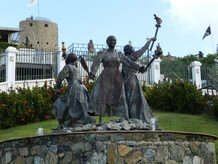"Queen Mary" Folksong: A Commemoration of 1878 Fireburn
The 1878 Fireburn was a labor protest for workers rights and labor reforms, primarily in the sugar industry. While abolition of slavery officially occurred on July 3rd 1848, many formally enslaved people were forced to go back to work on sugar plantations, as the monoculture economy and colonially structured society provided few avenues for other employment. Often, conditions were even worse than slavery, as workers were paid only 10-20 cents per day and not provided with minimal clothing, housing, and food rations as they were when enslaved.
In 1878, The Central Sugar Factory, subsidized by the Danish government, opened in Richmond, west of Christiansted. The Central Factory produced sugar on a larger scale, receiving cane from several estates and additional cane juice from underground pipes running from Peter’s Rest pumping station. At the factory, workers were given wages of 30-35 cents per day.
This discrepancy in wages, and grievances about the 1849 Labor Act roused workers to rally. The 1849 Labor Act stipulated that workers could only renew their labor contracts on Contract Day, October 1st. This law greatly limited worker’s freedom, forcing them to stay in a single job for the entirety of a year. They could only change jobs on Contract Day.
On Contract Day 1878, four women, Queen Mary Thomas, Queen Mathilda Macbean, Susanna “Bottom Belly” Abrahamson and Axeline “Queen Agnes” Salomon, led the labor protest. Much of the town of Frederiksted – where contracts were signed – burned, along with many neighboring estates on the West End of the island. The four queens were brought to Denmark and were imprisoned until tried. Eventually they were pardoned and allowed to return to St. Croix. Their labor revolt was a success and the 1849 Labor Act was repealed as a result.
This folksong speaks to the power of women and of the working class. Women working in the cane fields, did the same backbreaking work as men, yet were also more vulnerable to sexual assault and abuse from their masters during times of slavery, and their employers after slavery. The women also often were the ones responsible for supporting their children. While men and women were generally paid the same meager wages, an unmarried man’s wages went a lot farther than a single mother’s wages used to support her children as well as herself. Therefore, it is not surprising that women were the people leading the Fireburn, as they experienced some of the worst working conditions. The Fireburn is an example of women’s political power. These four queens had the ability to organize the majority of the working class to act against the oppressive sugar industry and the government’s oppressive labor laws. The fact that this version of the song is sung by school girls reflects the handing down of this story and political empowerment that comes with it to women of future generations.
The action described of burning down the jailhouse, the very place that was used to imprison runaway enslaved people, is symbolic of destroying the institutions of slavery and colonial rule. Through this imagery, the song compares the jailhouse to a sugar factory and Emancipation Day to the 1878 Fireburn. In many ways, the 1878 Fireburn was the true emancipation date. Enslaved people discussed burning down Fort Frederik when they demanded their freedom in 1848. However, protesters waited patiently until the Governor General arrived and declared them free. The radical 1878 act of burning down the west part of the island was the exclamation mark of this prolonged struggle for freedom. It drew the attention of the European leaders still in control of the economy and island, forcing them to recognize that the formally enslaved plantation workers were people whose actions had consequences that mattered. This event instigated the implementation of rights for the working class and a change in thought about how working class people and women were perceived – the beginning of a radical restructuring of politic, economic, and social institutions on St. Croix.
In addition, the song describes the workers using “trash” or the remains of the sugar cane stalk as fuel for the fire. By burning the cane stalks, the working class is both symbolically and literally able to take control of and destroy the crop that have been used to enslave them. It is also very intentional that the creators of this song used the word “trash” to describe the cane stalk. While Danish and other European colonial powers profited from the exportation of sugar and sugar products, by using the word trash, the Crucians show that the lucrative crop has been worthless to them. The wording brings to light that historically Europeans have exploited the labor of Crucians and resources of St. Croix.
It is also notable that the song is sung in Crucian. Crucian can be thought of both as an English-based language and dialect. English speakers can general understand Crucian if they listen closely; however, it is an amalgamation of languages. Many words and grammatical structures are derived from West African languages, yet it is complemented with Dutch, Danish, and Irish influence. Singing in Crucian demonstrates a reclaiming of agency and history. Enslaved Africans were forced to learn the language of their colonial oppressors, and school children even today are penalized for writing in Crucian rather than standard English for academic assignments. By singing this folksong in Crucian, Crucians claim words and language that are solely their own, rather than those forced upon them by oppressors. “Queen Mary” speaks of a revolutionary time with revolutionary words, allowing Crucians to celebrate their history of radical struggle against the sugar king.
Check out: "Queen Mary" Folksong: A Commemoration of 1878 Fireburn
St. Croix, U.S.V.I 1878 Uprising
Three Queens of the Virgin Islands
 Three Queens of the Virgin Islands
Three Queens of the Virgin Islands